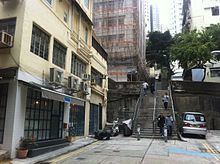Traditional Chinese 普慶坊 Hanyu Pinyin | Simplified Chinese 普庆坊 Yale Romanization pou hing fong | |
 | ||
Po Hing Fong (Chinese: 普慶坊) is a street in Sheung Wan, Hong Kong. It is also a cul-de-sac.
Contents
Map of Po Hing Fong, Tai Ping Shan, Hong Kong
In recent years, it has transformed into a new funky neighborhood in Hong Kong and nicknamed "Po Ho" as more artists and interesting shops, such as bohemian cafés, boutiques and design studios, have moved in.
History
Po Hing Fong was an original site of one of the Tong Meng Hui Reception Centres, an anti-Qing revolutionary organisation led by Dr. Sun Yat-sen, to provide asylums for revolutionaries.
Chau Siu-ki, a prominent Hong Kong businessman used to own two houses at Po Hing Fong. Sir Cecil Clementi, the then Governor of Hong Kong, lived at one of Chau's houses when he was a civil servant.
On 17 July 1925 shortly before 9 a.m., an extensive wall behind the houses near the Caine Road-Ladder Street end undermined by the heavy rains of the past three days. The flood gave out and swept away seven houses on Po Hing Fong where thirty families inhabited. Nearly eighty people were killed in the disaster, among those were Chau Siu-ki and many of his family members. Chau Tsun-nin, Chau Siu-ki's son, miraculous survived, due to his having fallen from his bed under a table which supported the weight of the bricks. Chau Tsun-nin later became member of the Executive Council and Legislative Council of Hong Kong.
